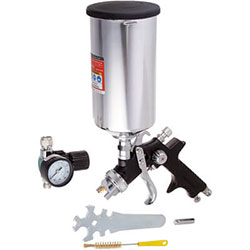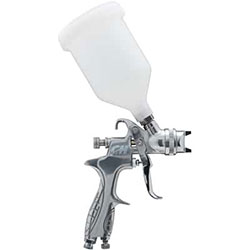The Best Paint Sprayers to Work With Compressors — Buyers Guide, Review, and Comparison
If you want to enter the realm of paint spraying royalty — you need one of the best paint sprayers to work with compressors. These ultimate tools — driven by an external pneumatic unit — offer precise control, a blemish-free finish, and a minimum of overspray. Compatible with a vast spectrum of coverings, from sealers and urethanes through to latexes and primers, they’re ideal for small to medium-scale projects where nothing but a flawless coat is acceptable — such as renovating antique furniture and completing a full motor vehicle respray. Highly customizable, with adjustable airflow, volume flow, and pressure input — you can tailor your gun to suit your paint type and base material’s demands.
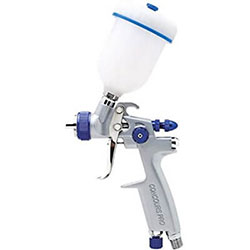
- Affordable pro-grade gun.
- Ideal for motor vehicles.
- Corrosion-preventing stainless steel inner chambers.
- Highly-rated compressor gun manufacturer.
- Multi-medium compatible.
Top Compressor Gun Products from Each Category
| IMAGE | PRODUCT | DETAILS | ||
|---|---|---|---|---|
|
Best HVLP Air Compressor Paint Gun 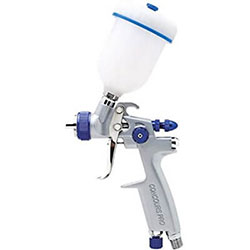
|
Best HVLP Air Compressor Paint Gun
|
Eastwood Concours Pro HVLP Detail Gun
|
Features
|
Check Price at Amazon Eastwood Concours Pro HVLP Review Eastwood Concours Pro HVLP Detail Gun Review |
|
Best LVLP Air Compressor Paint Spray Gun 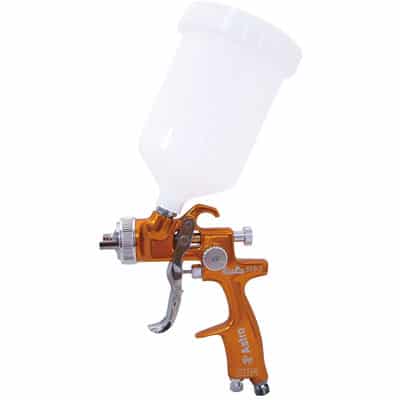
|
Best LVLP Air Compressor Paint Spray Gun
|
Astro EVOT14
|
Features
|
Check Price at Amazon Astro EVOT14 Review Astro EVOT14 Review |
|
Best Compressor Paint Sprayer Kit 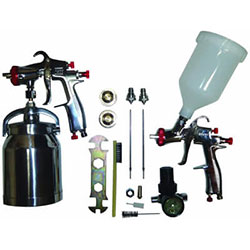
|
Best Compressor Paint Sprayer Kit
|
SprayIt SP-33310K LVLP Spray Gun Kit
|
Features
|
Check Price at Amazon SprayIt SP-33310K LVLP Review SprayIt SP-33310K LVLP Review |
HVLP Air Compressor
LVLP Air Compressor
Air Compressor
Best Paint Sprayers to Work With Compressors Reviews and Buying Guide
The best paint sprayers to work with compressors place you into a select group of power-painters.
These mighty units separate you from the average DIYer or journeyman contractor — providing the pinnacle of user-tailorability, finish, and efficiency on your coverage projects.
Depending on the model, these impressive shooters can be utilized for a massive spectrum of applications — from wood and furniture touch-ups though to a complete marine respray. And, being compatible with both thin and dense mediums — they’re as competent as delivering urethanes and varnishes as they are latex and chalk paints.
If you’re a newbie to the pneumatic painting world, check out my guide on How to Use a Spray Gun With an Air Compressor.
What Is a Compressor Paint Gun?
In the power painting world, there are three main formats of sprayers — turbines, airless, and pneumatics.
Turbines utilize a fan, or series of fans, to propel the coating medium. Airless units use a hydraulic pump to drive the paint, while a pneumatic machine draws on an external compressor to deliver your covering of choice.
The spray gun attaches to an electric or gasoline-powered air tank via a high-pressure hose. Air is delivered into the gun, sometimes with the pressure stepped-down by an inline regulator, where it drives the paint into the nozzle and becomes atomized — and coats your target project. Hence unlike their airless and hydraulic counterparts — these compressor guns aren’t operational straight-outta-the-box — you need an additional pneumatic tank.
Compressed air painting is literally the mother-of-all power-coating techniques — invented in 1887 by Joseph Binks. That said, this original machine was little more than a hand-pump — but the principle of utilizing the power of compressed air is the same as today’s modern power units.
Types of Paint Sprayer Air Compressor Guns
Ok, I’ll admit there are some additional and seriously niche shooters — such as LVMP (low-volume medium-pressure) and HVMP (high-volume medium-pressure) — but these guns are rare, and only suitable for a narrow range of applications.
HVLP Spray Gun Air Compressor Guns
As the name suggests, an HVLP spray gun utilizes a high-volume of air delivered at a low pressure, typically 10 PSI or less, to propel the coating medium.
This relatively small force — compared, say, to the 3000 PSI-plus of hydraulic units — allows for steady, controllable delivery. It minimizes overspray and bounceback — therefore saving on wastage and preventing dripping and pooling.
In technical terms, this is referred to as Transfer Efficiency, or as often witnessed on technical specifications, just TE. Typically, a gun is considered to be an HVLP shooter if it achieves a TE of 60 percent or higher.
So, in real terms that means a minimum of 60 percent of the paint leaving the gun hits the target — and isn’t lost to airborne atomization waste. That said, some state governorates (yep, even they have to interfere in DIY) will not consider a machine to be a true HVLP unit unless it achieves 65 percent transfer efficiency.
HVLP guns are excellent for small-to-medium scale projects where a fine finish is crucial. However, their low rate of paint delivery and the relative portability of an air compressor makes them unsuitable for substantial jobs — such as addressing fencing, outbuildings, and walls.
LVLP Air Pressure Sprayer
Unlike with HVLP guns, the government overlords haven’t set down legislation on what constitutes an LVLP unit — probably because these men and women in suits became so confused on the specifics of these different shooters, they thought it to be too much hassle — and decided their time was better spent playing golf or having an affair with an intern.
Hence, in their eyes, an LVLP is still an HVLP gun with a minimum TE of around 65 percent. However, in real terms, LVLP machines are more efficient.
Typically, the low-pressure low-volume shooters possess a TE of about 78 percent — although some examples, such as the Astro EVOT14, have an efficiency rating of over 80 percent.
This means an incredibly low amount of wastage, precise delivery, and the smoothest of finishes. It’s for this reason LVLP compressor guns are ideal for fine-work such as cabinet restoration and automotive resprays — where only a flawless coat is acceptable.
If you want more detailed information on the similarities and differences between HVLP and LVLP units — check out my HVLP vs LVLP article.
What Size Air Compressor Do I Need for Spray Painting?
The air compressor requirements for spray painting are based on two factors — PSI (pounds per square inch) output and airflow CFM (cubic feet per minute). Both HVLP and LVLP pneumatic guns typically require a minimum of 15-35 PSI output.
This is almost always within the capacities of most consumer-style compressors — meaning you don’t need an industrial-grade unit to drive these painters. And, if you already own a large capacity pneumatic machine — such as for powering your nail gun — you can usually adjust the brawn to a spray gun-compatible value via a dial on the tank.
However, the key factor is the CFM.
This is particularly crucial for the HVLP spray gun air compressor — as it needs high volumes of air to drive the coating medium — usually between 8 to 15 CFM. LVLP guns need a comparatively smaller CFM, as they utilize low volumes of airflow — often around 3 to 5 CFM.
In either case, always check the manufacturer’s specifications for the gun before purchase — to ensure your compressor has the ability to power the shooter.
Furthermore, many pneumatic gun models come complete with an inline regulator and gauge — allowing you to step down the PSI input from your compressor to a manageable level.
Are Pressure Pot Spray Systems the Same as Compressors?
No.
A pressure pot paint sprayer is an additional piece of equipment that fits inline between your existing compressor and your pneumatic gun.
The concept behind them is to provide a massive reserve for your painting medium — typically between two and 15 gallons — instead of the small gravity or siphon cups mounted on the gun itself. This allows you to cover vast swathes of area without constraint refilling of a mini paint container.
Generally speaking, you fill the floor-standing pot with paint and secure the lid. This ‘can’ is then pressurized via a hose from your compressor, which in turn feeds the coating medium from the pressure pot to the spray gun.
While useful tools for DIYers and contractors addressing massive areas — pressure pot spray gun setup is notoriously convoluted and especially challenging for the inexperienced user.
It means utilizing three pressure gauges — one on the compressor, one on the pot, and another on the pressure pot paint gun — to achieve the perfect output level. Furthermore, the numerous hoses can be a tripping hazard — and, once set up, the portability of the pressure tank paint sprayer is virtually zero.
Why Choose a Compressor Powered Spray Gun?
Here are a few reasons why opting for a compressor-driven unit may be the best option:
- High-transfer efficiency — saving wastage and money.
- Ultra-fine finish — the ultimate in the spray painting category.
- Multi-medium compatibility — from thin to dense paints.
- Customizable — an array of tips, nozzles, and needles allow you to tailor your gun.
- Considered by traditionalists to be the ‘true’ form of spray painting.
- A wide selection of replacement components.
- Fine adjustments — set pressure, airflow, fan size, fan pattern, and volume flow to suit your paint and target material.
Why You Should Not Choose a Compressor-Powered Spray Gun
Here is a selection of their downsides:
- Slow — with precision comes the disadvantage of seriously steady coverage.
- Unsuited to large-scale projects.
- Unlike turbines and airless units, they’re not self-contained machines — they need an additional compressor.
- Are the most complicated sprayers to set up.
- Unless you have a pressure pot, they need constant refilling.
- Incompatible with heavily viscous mediums such as block fillers and elastomerics — unlike to airless machines.
- Lack of portability — unlike compact handheld guns.
While this article includes only the best pneumatic guns in the market — individual DIY and contractor needs differ, making individual shooters more or less relevant to your requirements.
Here are the key features that I suggest checking out to ensure your spray gun meets your job’s demands and achieves the finish you need.
HVLP or LVLP
Furthermore, having a higher transfer efficiency, LVLP guns are not as wasteful as HVLP units, although their coverage speed is slower.
Tip Size
In general terms, the greater the tip diameter, the more viscous mediums the spray gun can propel.
For HVLP examples, a 1.4 mm tip or above will effortlessly cope with dense mediums such as latexes, whereas an LVLP will need a 1.5 mm tip for these thicker paints. The difference arises due to the higher volume of air driven through the HVLP gun, which permits the use of a narrow nozzle.
Naturally, a wide tip will allow the use of thin mediums — but this can lead to significant overspray and wastage. Hence, if your projects include low-viscosity paints such as urethanes, stains, and lacquers — consider a smaller tip size.
Many pneumatic guns include a choice of spray tips to ensure you have the perfect nozzle end for your current coating medium — such as the HVLP DeVilbiss FinishLine 4 and the LVLP SprayIt SP-33500K.
CFM Requirement
In practice, the CFM rating makes little difference to the function of your gun. However, having your shiny new shooter delivered to your door only to discover it’s not going to work with your compressor is seriously disappointing.
Siphon or Gravity-Fed
Typically, pneumatic sprayers come in two forms — gravity and siphon-fed. A gravity gun has the paint container mounted on the top of the gun — while a siphon-feeding unit has it on the bottom.
As the name suggests, the former relies on gravity to draw the paint into the shooter’s barrel. Conversely, a siphon unit utilizes a vacuum to suck the coating medium into the unit.
Hence gravity guns require less compressor pressure to propel paint (as it’s supplemented by nature’s downward force). Typically this leads to less overspray, pooling, and dripping — and therefore a finer finish.
The downsides are that they have a high center of gravity — ironically — which can make wielding them accurately a challenge. Furthermore, their top-mounted design makes them considerably taller than bottom-feeding machines — which can make access to confined spaces difficult.
Paint Container Volume
As both HVLP and LVLP compressor guns are typically used for completing small to medium-scale projects — it’s unusual to find one with a paint cup capacity in excess of 1.06 quarts. This in contrast to the 1.5-quart plus capacity of many external turbine machines — such as the Wagner FLEXiO 5000 — which are designed for more expansive work.
However, cup sizes do vary in size across gun models, from 1.06-quarts down to 0.11-quarts. When selecting your air unit, consider that a larger volume container requires less refilling during your projects — although it increases the weight, which may induce the onset of fatigue.
Additional Accessories and Kits
Additionally, there are products that arrive as complete kits — which can include gauges, regulators, and a choice of paint cups and guns.
HVLP Air Compressor Paint Sprayers
HVLP Paint Gun for Air Compressor Comparison Table
| IMAGE | PRODUCT | DETAILS | ||
|---|---|---|---|---|
 |
Eastwood Concours Pro HVLP Detail Gun
|
Features
|
Check Price at Amazon | |
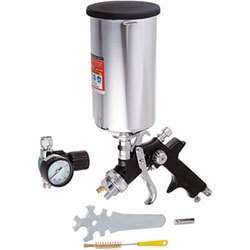
|
Ingersoll Rand 270G Edge
|
Features
|
Check Price at Amazon | |
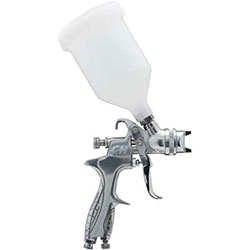
|
Campbell Hausfeld DH580000AV
|
Features
|
Check Price at Amazon | |
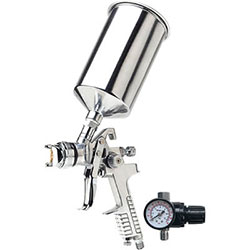 |
Vaper 19114 Gravity Feed Spray Gun
|
Features
|
Check Price at Amazon | |
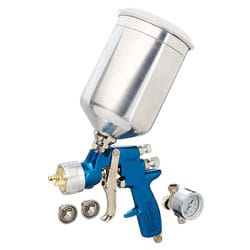 |
DeVilbiss FinishLine 4 FLG-670
|
Features
|
Check Price at Amazon | |
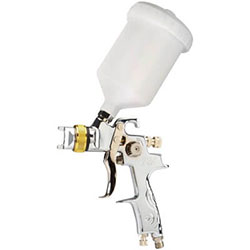 |
Central Pneumatic HVLP Touch Up Spray Gun
|
Features
|
Check Price at Amazon |
Our Picks of the Best Air Compressor Paint Sprayer for HVLP
Eastwood Concours Pro HVLP Gun
This affordable tool — contractor-grade yet within reach of the DIYers pocket — features a versatile 1.3 mm stainless steel needle. Giving a flaw-free finish, it’s as suited to propelling waterborne mediums as it is oil-based paints. Furthermore, should you wish to utilize seriously viscous fluids in the gun, it can accommodate up to a 2.0 mm diameter tip (available separately from the manufacturer).
DIYers will be pleased to know this gun doesn’t require a high pressure sprayer compressor — just 6.5 CFM at 30 PSI. Meaning it’s within the capabilities of most consumer-style pneumatic units.
For top-mounted container devotees, this shooter boasts a gravity-feeding 0.63-quart acetyl cup — allowing every ounce of your coating medium to be used with little wastage. Furthermore, it features four material flow volume settings.
Features
- Excellent automotive resprayer.
- Corrosion-busting stainless steel inners.
- Respected compressor gun manufacturer.
- Multi-medium compatible.
- Excellent online air compressor paint sprayer reviews.
- Design
- Functionality
- Price
Ingersoll Rand 270G Edge
Incorporating a substantial 1.03-quart paint container, this unit should negate the requirement for frequent replenishment on larger jobs — eliminating wasted time and concomitant mess. Furthermore, featuring a durable metal construction, this cup should withstand the challenges of extreme contractor use.
Its 1.5 mm tip copes effortlessly with stains, sealers, lacquers, and polyurethanes, although more dense mediums may require some thinning. And, boasting high transfer efficiency, wastage and overspray are minimized.
The key to this unit is its user-tailorability. In addition to the standard compressor gun dials to permit airflow and material flow adjustment — the unit also arrives complete with an inline regulator and gauge — enabling you to set the perfect pressure input to suit both your painting medium and project’s demands.
Features
- Includes cleaning brush, gun wrench, and hex key.
- Impressive online spray gun pressure sprayer reviews.
- Durable metal cup.
- Incorporated ladder hook.
- Includes filters.
- Design
- Functionality
- Price
Campbell Hausfeld DH580000AV
Incorporating a 1.4 mm tip, this gravity-fed unit offers pleasing atomization and copes admirably with the cabinet-coating staples of enamels, lacquers, urethanes, and clear coats. However, due to its narrow chambers to achieve the fine spray — it’s not suitable for use with heavily viscous paints.
A 0.63-quart acrylic cup with easy-fill access provides sufficient capacity for the majority of furniture work. Furthermore, being top-mounted, ensures your delicate fingers don’t become trapped between the container and the trigger.
The gun body is constructed from robust polished aluminum — offering a pleasing aesthetic and protection from corrosion. And, being a precise furniture addressing tool — you can adjust airflow and material volume flow.
Features
- No large compressor for HVLP spray gun needed — just 4 CFM at 40 PSI.
- Incorporated ladder hook.
- In addition to the pressure paint gun, it includes a wrench, filters, and a brush.
- Reduced overspray.
- Easy-clean paint container.
- Design
- Functionality
- Price
Vaper 19114 Gravity Feed Spray Gun
This compressor-driven gun arrives complete with a paint gun stand — securing your unit and leaving both hands free for replenishment of the generous 0.84-quart paint cup. Its substantial gravity-feeding paint container is built from anodized aluminum — promising reassuring durability while remaining lightweight.
A locking pressure gauge and regulator keeps this unit running at the optimum pressure suitable for your coating medium — and the gun also allows you to alter the spray pattern, airflow volume, and material volume flow.
Features
- A compressed air tank sprayer gun with 7.5 to 9 CFM requirement.
- Complete with a holding stand for effortless refilling.
- Easy-turn dials.
- Contractor-grade.
- Respected HVLP gun manufacturer.
- Design
- Functionality
- Price
DeVilbiss FinishLine 4 FLG-670
Anodized internals and externals promote longevity by reducing the risk of corrosion and eliminating the likelihood of oxidation. With low overspray, this gun cuts back on wastage and delivers a coat worthy of a motor showroom.
The gun arrives with a selection of three stainless steel tips — 1.3, 1.5, and 1.8 mm — enabling you to choose the most suitable nozzle end to match the viscosity of your paint type.
This shooter has a low HVLP spray gun air compressor air requirement — just 13 CFM at 23 PSI — making it ideal for use with DIY-sized pneumatic units. Additionally, it includes a pressure regulator and valve to guarantee the correct pressure input for a flawless coat.
Features
- High-grade internal stainless steel components.
- Adjustable material and air flow.
- Uniform spray pattern.
- Excellent automotive plasti dip compressor gun.
- Bold eye-catching blue aesthetic.
- Design
- Functionality
- Price
Central Pneumatic HVLP Touch Up Spray Gun
Comprising a stainless steel 0.8 mm tip, it’s an excellent varnish, lacquer, pearl, shellac, and clear coat shooter. While too narrow in diameter to deliver thicker mediums, the gun is compatible with nozzle heads up to 2.0 mm.
Complete with an air regulator and gauge, this gun is suitable for use with consumer-style compressors, requiring a modest 5.6 CFM. Additionally, lightweight at only 1.25 pounds and boasting an ergonomic knurled handle — the unit promotes stamina and allows you to finish your work in a timely and efficient manner.
Features
- Adjustable pressure, air flow, and volume delivery.
- Durable construction.
- Suitable for window frames, baseboard scuffs, and automotive scratches.
- Incorporated ladder hook.
- Lightweight.
- Design
- Functionality
- Price
LVLP Compressed Air Paint Sprayer
LVLP Paint Sprayer for Air Compressor Comparison Table
| IMAGE | PRODUCT | DETAILS | ||
|---|---|---|---|---|
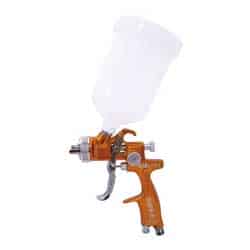 |
Astro EVOT14
|
Features
|
Check Price at Amazon | |
<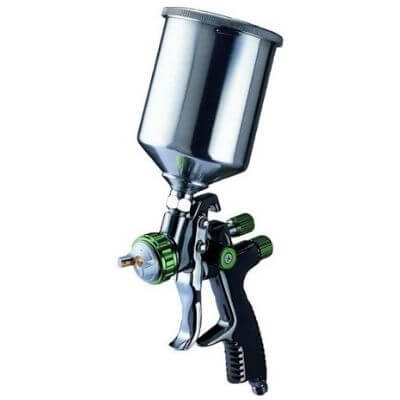
|
Transtar 7718S
|
Features
|
Check Price at Amazon | |
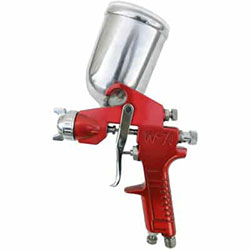 |
SprayIt SP-352 Gravity Feed Spray Gun
|
Features
|
Check Price at Amazon | |
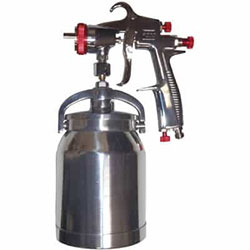 |
SprayIt Spray Gun SP-31000
|
Features
|
Check Price at Amazon |
Our Picks of the Best LVLP Air Pressure Paint Gun
Astro EVOT14
The shooter’s body is both anodized and forged — offering durability through hardcore use while shielding against corrosion and oxidation. Despite its robust nature, it remains pleasingly lightweight, making it effortless to wield. Furthermore, a proprietary feather-pull trigger prevents digit fatigue — crucial on time-extensive projects.
The gun boasts proprietary ‘air curtain’ tech — keeping the spray fan concentrated on your target material and not lost to atmospheric atomization. And, a trademarked quick-thread system allows for rapid attachment and detachment of the paint container and nozzle — promoting speedy and straightforward cleaning.
Features
- EVO-T technology for ultra-fine atomization.
- Ideal for urethanes, lacquers, varnishes, and clear coats.
- CFM of 11.5 and 15 PSI.
- Excellent for vehicle work.
- CNC machining eliminates gasket requirements.
- Design
- Functionality
- Price
Transtar 7718S
Featuring a substantial 1.8 mm stainless steel tip, this hardcore shooter copes admirably with dense priming materials, yet still ensuring a smooth and pleasing finish with its fine atomization. Furthermore, its ability to propel thick mediums also makes it an excellent self-etching, polyester, filler, and air compressor paint sprayer latex gun.
However, despite its ability to knock out seriously heavy viscosity paints and coverings, it has a surprisingly low compressor requirement — just 4.2 CFM at a pressure input of 22 PSI.
This LVLP pneumatic gun also incorporates pleasing user-tailorability, with its adjustable pressure delivery, material flow, and airflow.
Features
- Wide spray width — up to 12 inches.
- Low overspray with a transfer efficiency of 65 percent.
- Excellent vehicle restoring compressor gun.
- Corrosion-preventing tip.
- Includes a ladder hook incorporated into the gun body.
- Design
- Functionality
- Price
SprayIt SP-352 Gravity Feed Spray Gun
With dimensions of just 4.5 by six inches, and with a weight of only one pound, this mini LVLP shooter enables versatility, accuracy, and a rewarding finish. It boasts an unusual, side-mounted swiveling gravity cup — meaning that you can tailor the container’s direction away from the vertical to match your spraying angle. This allows you to manipulate your gun to reach hard-to-access areas without affecting the paint flow.
This compressor-driven gun features a 1.5 mm stainless steel tip — making it suitable for both thin and viscous paints. That said, should your projects mainly involve low-viscosity mediums, you can purchase narrower diameter tips from the manufacturer.
Home-pneumatic compatible, needing only 4.2 CFM at 30 PSI, this unit is within reach of the DIYer. Additionally, its reserved 5.5 to 7.5-inch spray fan pattern allows for accurate delivery and precise control.
Features
- Not a high pressure paint sprayer — just 4.2 CFM at 30 PSI.
- Adjustable air, pressure input, and material volume flow.
- Innovative side-mounted swivel paint container.
- Excellent hobbyist machine.
- Impressively lightweight.
- Design
- Functionality
- Price
SprayIt Spray Gun SP-31000
Incorporating a sizable 1.06-quart siphon aluminum cup, it enables reassuring capacity for those more expansive home and contractor jobs. Additionally, not only does this cup permit rapid paint replenishment with its quick-connect tech, but it also promotes longevity with its protective anodized build.
Although this gun will cope admirably with more expansive jobs, you don’t need the mother-of-all compressor units — needing just 3.5 CFM at 30 PSI. Hence, making it compatible with the majority of home garage-sized pneumatic powerhouses.
The nozzle permits a spray width of 7.0 to 10.9 inches — allowing you to step down the delivery for accurate work, and then crank it up for more expansive areas. Furthermore, this compressor gun arrives with a gun wrench and cleaning brush.
An incorporated ladder hook permits safe storage when working on high-level projects, while a heavily knurled metal handle ensures a stable grip even when using the unit with gloved or paint-drenched hands.
Features
- Knurled handle for precise control.
- 60 PSI maximum pressure.
- Smooth trigger pull.
- Ideal siphon gun for medium to large jobs.
- Ladder hook built into the gun barrel.
- Design
- Functionality
- Price
Air Compressor Paint Sprayer Kit
Furthermore, sometimes offering more than one gun, they can be a savvy choice for the experienced power-painter seeking an affordable solution — enabling greater versatility in medium delivery and project application.
HVLP and LVLP Spray Paint Compressor Kit Comparison Table
| IMAGE | PRODUCT | DETAILS | ||
|---|---|---|---|---|
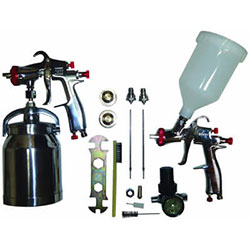 |
SprayIt SP-33310K LVLP Spray Gun Kit
|
Features
|
Check Price at Amazon | |
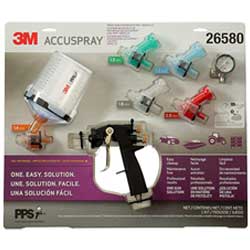 |
3M Accuspray Paint Gun Kit
|
Features
|
Check Price at Amazon | |
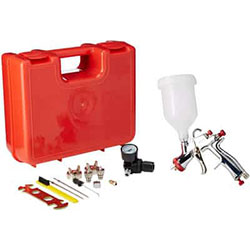 |
SprayIt SP-33000K Kit
|
Features
|
Check Price at Amazon | |
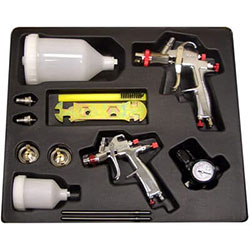 |
SprayIt SP-33500K
|
Features
|
Check Price at Amazon |
Our Picks of the Best HVLP and LVLP Air Compressor Paint Gun Kit
SprayIt SP-33310K LVLP Spray Gun Kit
It features the gravity-fed SP-33000K shooter and the siphon-fed SP-31000 gun. Hence, it permits you to enjoy the super-fine coat delivered by the top-mounted unit and the balance and compact design of the bottom-fuelled machine.
In addition to these two compressor pressure spray guns, the set includes a pair of paint containers. The SP-33000 features a rapid-clean 0.63-quart cup, and the SP-31000 a generous 1.06-quart container that’s excellent for more expansive jobs.
Both of these high-grade units facilitate user-tailorable pressure input, airflow, and material volume flow. And, in addition to the cups, guns, and tips, the kit includes a regulator, wrenches, and cleaning brushes.
- Paint sprayer with air compressor requirement of 3.5 to 3.9 CFM at 30 PSI.
- Twin guns permit rapid color switching.
- Vast spectrum range of stainless tip sizes.
- Features a gun for every project.
- Spray fan widths of 7.0 to 10.9 inches.
- Design
- Functionality
- Price
3M Accuspray Paint Gun Kit
Remarkably comprehensive, this set features all the tools you need to begin power-painting straight from the box — well, as long as you already have a compressor capable of knocking out 13 CFM.
Its 0.68-quart gravity feeding cup has a novel feature — external pre-printed mix ratios. In combination with the see-through container, it permits you to effortlessly thin your coating medium to the perfect dilution. Additionally, this set includes disposable cup bags — empowering you to make swift color switches and remove the hassle of post-project cleaning.
The gun has 360-degree spraying flexibility — meaning it works perfectly well when used away from the horizontal — thus enabling the shooter to be utilized on high-level targets such as ceilings.
- Includes the useful paint sprayer air compressor attachment of a pressure gauge.
- Mix ratios detailed on the paint cup.
- Arrives with nozzles, liners, lids, and tips.
- User-tailorable material and airflow.
- Ideal newbie compressor gun kit.
- Design
- Functionality
- Price
SprayIt SP-33000K Kit
Needing only 3.5 to 3.9 CFM at 30 PSI — this shooter will happily run off most consumer-style pneumatic units. The corrosion-proof aluminum gun should promote fatigue-free operation on most substantial projects, while a gravity-feeding 0.63-quart cup enables the low-pressure requirement.
In addition to the gun and tips, this set features a pressure gauge paint sprayer attachment for air compressor, extra needles, a cleaning brush, and a gun wrench. Furthermore, the shooter and accessories arrive complete in a hard storage case — allowing you to keep everything safe and secure, ensure straightforward portability, and add vital protection to your power tool.
- 7.0 to 10.9-inch spray width.
- Adjustable spray pattern, airflow, volume flow, and pressure input.
- Excellent for small compressors.
- Easy-turn dials.
- Rapid-clean acrylic paint container.
- Design
- Functionality
- Price
SprayIt SP-33500K Kit
Firstly, the SP-33500K gun comes with a reserved 0.13-quart container, suitable for accurate and fine work such as spraying wood trim and completing vehicle touch-ups. Conversely, the SP-33000K unit features a 0.63-quart acrylic cup — meaning it’s ideal for addressing more substantial projects such as a complete cabinet overhaul.
Both of these guns can be driven by smaller compressor units — a minuscule 2.4 CFM at 30 PSI requirement for the SP-33500K and a modest 3.5 CFM at 30 PSI in relation to the SP-33000K.
User-practicality is at the heart of these two shooters — with back-mounted easy-turn dials permitting fingertip adjustment of the volume flow and air flow. Furthermore, this exhaustive set boasts a cleaning brush, regulator and gauge, and a gun wrench.
- Light yet durable aluminum build.
- Multi-project and multi-medium compatible with two guns.
- Integrated ladder hooks.
- Easy-pull trigger.
- Spray width facility of 4 to 10.9 inches.
- Design
- Functionality
- Price
Conclusion
Compressor spray guns are the pinnacle of power painting — offering the cleanest of finishes, the widest user-tailorability, and the height in efficiency.
Compatible with a vast spectrum of paint mediums and providing minimal bounceback and overspray — these tools are suitable for a multitude of applications, from staining shelves and restoring furniture through to respraying vehicles and coating boats.
When selecting your ideal gun, consider whether to opt for HVLP or LVLP — the former providing more rapid coverage and the latter the ultimate in flawless finishes. Additionally, choose a gun with a tip — or tips — to match your coating medium, a paint cup that offers a sufficient capacity for your projects, and a CFM rating that’s suited to your compressor.
Admittedly, they’re not for everyone. DIYers and contractors demanding the most rapid of coverage should go for an airless machine. And casual users looking for a weekend project gun should consider a handheld HVLP turbine.
But, if you want to join the ranks of power-spraying royalty — you need one of the best paint sprayers to work with compressors.
Spray Paint Air Compressor Guns FAQs
Q: What Size Air Compressor for Paint Sprayer?
The majority of both HVLP and LVLP spray guns require a pressure input of between 15-30 PSI — meaning they’re suitable for use with smaller size pneumatic units.
Q: Can I Use a HVLP Spray Gun With Small Compressor?
Yes, you don’t need an industrial-grade air compressor to power an HVLP spray gun. Generally speaking, these shooters will run off a pneumatic unit that can knock out between 15-30 PSI — although, always check the manufacturer’s specifications, as the pressure demands vary across models.
Q: How Do You Use a Compressor Spray Gun?
Although pneumatic spraying may be a little challenging for compressor newbies — with a little practice, DIYers can achieve amazing results. For a detailed 101 guide, check out my How To Use a Spray Gun With an Air Compressor article.
Q: What Size Air Compressor for HVLP Spray Gun?
The HVLP spray gun compressor requirements depend upon the make and model of the shooter. That said, the majority of HVLP shooters work off a pressure input of around 15-30 PSI and 8-15 CFM.
Q: Can You Spray Latex Paint Using Air Compressor?
Yes. Using a latex paint sprayer for air compressor isn’t difficult — but you need to ensure that your gun has the power and nozzle diameter to cope with this dense paint. The Transtar 7118S is an ideal viscous medium compressor spray gun.
Q: What Size Air Compressor Do I Need to Paint a Car?
A small, consumer-style compressor is suitable for vehicle respraying — as you will typically be using an HVLP or LVLP gun. This means a PSI demand of about 15-30 PSI, and a CFM rating of 8 to 15 for an HVLP, and 3 to 5 CFM for an LVLP.
Q: Where Can I Find an Airless Compressor Sprayer?
You cannot. An airless sprayer utilizes a hydraulic pump to drive the paint through the gun, whereas a pneumatic unit uses compressed air.
Q: What Are the LVLP Spray Gun Compressor Requirements?
LVLP guns can run perfectly well off small pneumatic units. The exact requirements vary across models, although typically they need a 3 to 5 CFM rating and a pressure input of 15-30 PSI.


